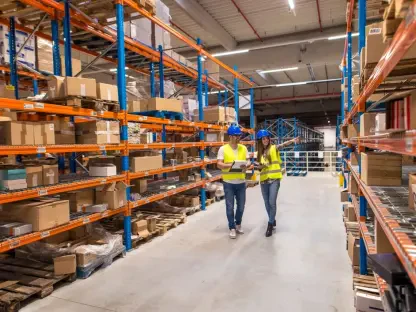In the ever-evolving landscape of logistics, where transparency and connectivity are paramount, Rohit Laila stands out as an expert with decades of experience. His insights into the intersection of technology and supply chains shed light on how industries navigate uncertainties and strive for efficiency. Our conversation deep dives into the nuances of supply chain management, covering innovative platforms, security measures, and sustainability efforts shaping the logistics industry’s future.
Can you describe the importance of end-to-end visibility in today’s supply chain management?
End-to-end visibility is crucial because it provides businesses with a comprehensive view of the entire supply chain process. Knowing precisely when and where every component of a supply chain is, from raw material acquisition to final delivery, allows companies to anticipate and address potential disruptions. This holistic insight transforms logistics planning from reactive to proactive, significantly improving efficiency and customer satisfaction.
How does the OSCA Global Logistics platform provide granularity in supply chain visibility?
The OSCA platform excels by offering SKU-level visibility very early in the product’s lifecycle. It bridges the gap from the development stage through packing, enabling decision-makers to access real-time data that informs every segment of the supply chain. This granular visibility means businesses can make informed and timely decisions, optimizing each stage of the logistics process and enhancing overall productivity.
How does early SKU-level visibility benefit distribution centers?
Early SKU-level visibility allows distribution centers to better prepare for incoming shipments. By knowing in advance what’s coming and when, DCs can prioritize unloading, allocate resources more effectively, and ensure that goods move swiftly and accurately through the supply chain. In turn, this agility improves response times to market demands and heightens customer satisfaction.
In what ways can OSCA’s platform help businesses respond to supply chain disruptions caused by geopolitical tensions, climate events, or port congestion?
OSCA’s platform equips businesses with the data needed to act swiftly in the face of disruptions. By integrating real-time insights from production through to shipping, the platform allows companies to adjust logistics strategies on the fly, be it shifting modes of transport or rerouting shipments. This adaptability ensures that businesses remain resilient, even in the face of unforeseen challenges like geopolitical tensions or natural disasters.
Could you explain how the platform integrates supplier, lab, and logistics data to empower businesses?
By unifying data streams from suppliers, labs, and logistics providers within a single platform, OSCA fosters seamless communication and collaboration across all stakeholders. This integration not only allows for smoother operation but also empowers businesses with actionable insights drawn from various stages of production, ensuring all parties are aligned and informed.
What role does sustainability play in Setlog’s supply chain strategies, and how does the platform facilitate CO₂ tracking?
Sustainability is at the forefront of Setlog’s strategies, with a particular emphasis on minimizing carbon footprints. The OSCA platform allows detailed CO₂ tracking at the SKU level, enabling companies to assess and alter their logistics approaches to reduce emissions while maintaining performance. This function is crucial for meeting environmental goals and creating a more sustainable supply chain ecosystem.
How can companies optimize their transport modes to balance emissions and service levels?
To achieve optimal balance, companies must leverage data-driven insights to make informed decisions about transport modes. By analyzing factors like speed, cost, and emissions, businesses can strategically choose when to use high-speed air freight versus cost-effective sea transport. This strategic approach not only reduces environmental impact but also ensures that service levels are not compromised.
What specific security measures does Setlog implement to protect sensitive data on the OSCA platform?
Setlog prioritizes security by incorporating robust systems with strict access controls. Role-based permissions ensure that only authorized personnel can access or modify data, safeguarding sensitive information from both internal and external threats. Additionally, Setlog collaborates with certified data processing partners to adhere to stringent security standards globally.
How does the platform ensure that only authorized users access critical data?
The platform uses role-based access controls to enforce data security, meaning that users only have access to the information necessary for their roles. This approach minimizes the risk of unauthorized data manipulation or breaches, securing critical information while providing users with the tools they need to perform their tasks effectively.
What are the challenges faced by the industry due to labor shortages, particularly in logistics, and how does Setlog address them?
Labor shortages present a significant hurdle, especially in logistics roles like customs and warehouse operations. Setlog addresses this by supporting Fourth-Party Logistics models where a single provider manages full logistics operations. This shift allows companies to concentrate on core business activities, while skilled logistics partners handle the complexities of logistics operations.
Can you elaborate on the Fourth-Party Logistics (4PL) models Setlog is supporting?
Setlog is championing 4PL models by helping companies like Rhenus in orchestrating comprehensive logistics frameworks. This approach enables providers to manage entire supply chain processes, from carrier selection to distribution, offering businesses efficiency gains and reducing the need for in-house logistics expertise, particularly crucial amid labor shortages.
How is Setlog embedding AI into its operational workflows to enhance efficiency?
AI plays a transformative role in Setlog’s operations by streamlining workflows and reducing manual intervention. From analyzing quality control reports to enabling real-time chatbot support for supply chain queries, AI enhances decision-making and operational efficiency, allowing employees to focus on strategic and exceptional scenarios instead of routine tasks.
What are some practical applications of AI within the OSCA platform, such as in document processing or chatbot support?
AI within the OSCA platform automates complex processes, such as interpreting lab reports and triggering subsequent actions or assisting with routine supply chain inquiries through chatbots. These applications minimize manual workload and accelerate processes, providing users with accurate, timely information that aids in decision-making.
How does the integration of AI reduce the need for manual intervention in supply chain management?
AI integration allows for automatic handling of data-intensive tasks that would typically require considerable human resources. By streamlining tasks like document interpretation and real-time system queries, AI frees up personnel to engage in more critical, high-level work, enhancing overall operational efficiency without sacrificing accuracy.
How is Setlog positioning itself in the US market compared to Europe, especially in terms of digital logistics?
Setlog is actively expanding its footprint in the US by capitalizing on the growing acceptance of digital logistics platforms. While Europe is rich in experience, the advanced digital infrastructure and tech-savvy market in the US offer incredible opportunities for innovations like OSCA to thrive. This enables Setlog to tailor its solutions to regional demands effectively.
Could you discuss Setlog’s involvement with the Open Logistics Foundation and any recent innovations, such as digital air waybills?
Setlog collaborates with the Open Logistics Foundation to drive innovation in digital logistics solutions, like digital air waybills, which aim to eliminate manual workflow inefficiencies. These innovations significantly speed up supply chain operations by reducing paperwork and enhancing data accuracy, benefiting stakeholders across the supply chain.
Why is it crucial for modern supply chains to move beyond fragmented software and Excel spreadsheets?
Modern supply chains demand agility and real-time responsiveness, which fragmented tools and spreadsheets cannot provide. Integrated platforms like OSCA offer cohesive ecosystems where all stakeholders have access to accurate, timely information, enabling them to make swift, informed decisions that are crucial in an increasingly dynamic global market.
How does the OSCA platform create a collaborative ecosystem for supply chain stakeholders?
The OSCA platform facilitates collaboration by integrating data and communication channels within a single interface accessible to all supply chain participants. This unification ensures transparency, aligning goals and enabling a synchronized response to challenges, enhancing both agility and cohesion among stakeholders.
In what ways can transparency and collaboration prepare businesses for future challenges in supply chain management?
Transparency and collaboration offer businesses the resilience needed to navigate future supply chain challenges. By fostering comprehensive data sharing and stakeholder alignment, companies can anticipate shifts, adapt strategies quickly, and mitigate risks effectively, ensuring stability and continuity even amidst uncertainty.
Based on your experience, what is the most challenging aspect of achieving clarity in the supply chain industry today?
The most challenging aspect is effectively managing the sheer volume and complexity of data flowing through the supply chain. Ensuring that this data is not only accessible but also actionable requires sophisticated technological solutions and a culture of collaboration among stakeholders, which can be difficult to achieve but is essential for true clarity.









